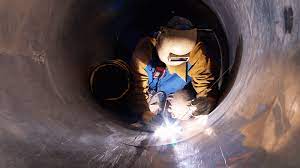When employees work in confined spaces, it’s much harder to avoid and respond to hazards. Entries and exits may be limited, and the area may only be large enough for workers to perform their duties.
Confined spaces training helps workers identify hazards and overcome them to maximise safety and reduce the risk of injury. There are several industries that require this specialised training.

5 Industries Where Employees Work in Confined Spaces
1. Mining
An estimated 278,800 Australians work in the mining industry, accounting for 2.1% of the workforce population. But each year, many mining employees are injured or even killed in accidents caused by slides or cave-ins. Confined spaces training and appropriate risk assessment can reduce the threat of these types of accidents.
Why is confined spaces training necessary for this industry?
- Some tunnel areas are considered confined spaces.
- Some mines and tunnels have confined spaces within them, like tanks, bins or water storage dams.
- Mines may have atmospheric hazards like low oxygen levels, vapours, fumes, gases and flammable agents. These hazards can make it more difficult to escape in case of danger.
Confined spaces training is essential for the mining industry for both risk planning and minimising accidents and injuries.
2. Construction
Like mining, construction is one of the country’s biggest employes – and an inherently dangerous industry. In 2018, 24 construction workers died in work-related accidents.
Construction sites often contain confined spaces, such as:
- Crawl spaces
- Trenches
- Drainage pipes
- Tanks
- Manholes
These areas are not designed for continuous occupancy, and it can be difficult to escape if there is an emergency.
Any worker who needs to enter a confined space must undergo confined spaces training in the construction industry. In addition, stand-by personnel and managers or supervisors must receive the same training.
3. Transport and Storage
It may not seem like an obvious industry for confined spaces, but transport and storage does require confined spaces training.
Drivers must understand how to safely transport and store hazardous materials (like combustible gases) while in the confined space of a vehicle. Without the proper training and protocols, these confined spaces can quickly become dangerous.
4. Manufacturing
In some cases, manufacturing employees may be required to perform their duties in confined spaces with limited exits that are not designed for continuous occupation.
Heavy machinery and/or atmospheric hazards can create dangerous conditions for workers.
Confined spaces training can help workers identify hazards, use the appropriate safety equipment and appropriately respond to dangers.
5. Agriculture
In some cases, agricultural work will require employees to perform their duties in confined spaces, such as silos, water tanks or grain storage. These confined areas can pose serious OHS risks, including:
- Poisoning
- Suffocation
- Oxygen deficiency (grain, for example, can absorb oxygen in silos)
- Airborne contaminants
- Carbon monoxide poisoning
Confined spaces training is crucial for the agricultural industry to keep workers safe. Additionally, atmospheric testing and protective equipment should be used to minimise the risk of injury and death.
These five industries require confined spaces training to keep employees safe and minimise the risk of injury or death.
